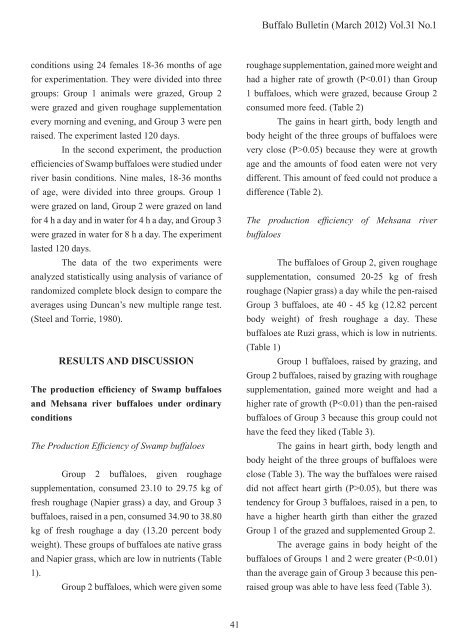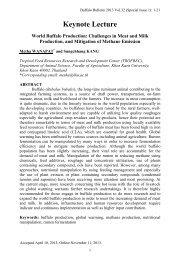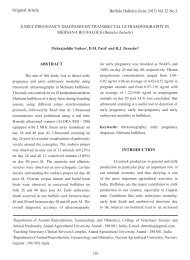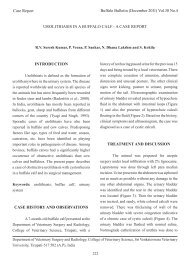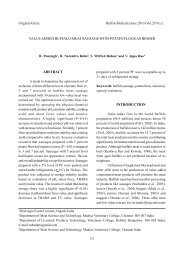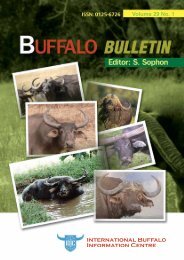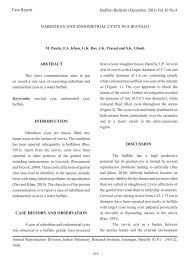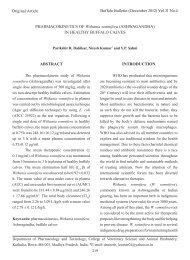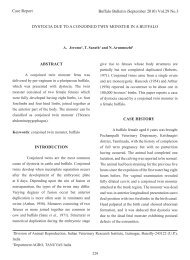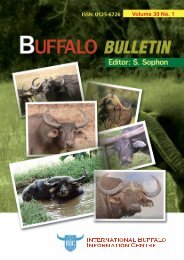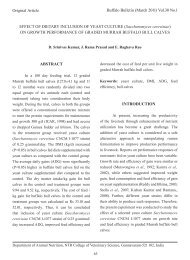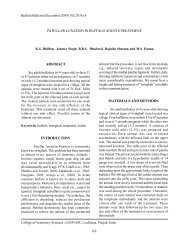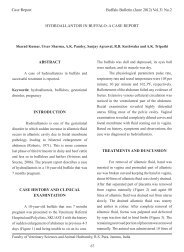Production efficiency of Swamp buffaloes and Mehsana river buffaloes
Production efficiency of Swamp buffaloes and Mehsana river buffaloes
Production efficiency of Swamp buffaloes and Mehsana river buffaloes
You also want an ePaper? Increase the reach of your titles
YUMPU automatically turns print PDFs into web optimized ePapers that Google loves.
Buffalo Bulletin (March 2012) Vol.31 No.1conditions using 24 females 18-36 months <strong>of</strong> agefor experimentation. They were divided into threegroups: Group 1 animals were grazed, Group 2were grazed <strong>and</strong> given roughage supplementationevery morning <strong>and</strong> evening, <strong>and</strong> Group 3 were penraised. The experiment lasted 120 days.In the second experiment, the productionefficiencies <strong>of</strong> <strong>Swamp</strong> <strong>buffaloes</strong> were studied under<strong>river</strong> basin conditions. Nine males, 18-36 months<strong>of</strong> age, were divided into three groups. Group 1were grazed on l<strong>and</strong>, Group 2 were grazed on l<strong>and</strong>for 4 h a day <strong>and</strong> in water for 4 h a day, <strong>and</strong> Group 3were grazed in water for 8 h a day. The experimentlasted 120 days.The data <strong>of</strong> the two experiments wereanalyzed statistically using analysis <strong>of</strong> variance <strong>of</strong>r<strong>and</strong>omized complete block design to compare theaverages using Duncan’s new multiple range test.(Steel <strong>and</strong> Torrie, 1980).RESULTS AND DISCUSSIONThe production <strong>efficiency</strong> <strong>of</strong> <strong>Swamp</strong> <strong>buffaloes</strong><strong>and</strong> <strong>Mehsana</strong> <strong>river</strong> <strong>buffaloes</strong> under ordinaryconditionsThe <strong>Production</strong> Effi ciency <strong>of</strong> <strong>Swamp</strong> <strong>buffaloes</strong>Group 2 <strong>buffaloes</strong>, given roughagesupplementation, consumed 23.10 to 29.75 kg <strong>of</strong>fresh roughage (Napier grass) a day, <strong>and</strong> Group 3<strong>buffaloes</strong>, raised in a pen, consumed 34.90 to 38.80kg <strong>of</strong> fresh roughage a day (13.20 percent bodyweight). These groups <strong>of</strong> <strong>buffaloes</strong> ate native grass<strong>and</strong> Napier grass, which are low in nutrients (Table1).Group 2 <strong>buffaloes</strong>, which were given someroughage supplementation, gained more weight <strong>and</strong>had a higher rate <strong>of</strong> growth (P0.05) because they were at growthage <strong>and</strong> the amounts <strong>of</strong> food eaten were not verydifferent. This amount <strong>of</strong> feed could not produce adifference (Table 2).The production effi ciency <strong>of</strong> <strong>Mehsana</strong> <strong>river</strong><strong>buffaloes</strong>The <strong>buffaloes</strong> <strong>of</strong> Group 2, given roughagesupplementation, consumed 20-25 kg <strong>of</strong> freshroughage (Napier grass) a day while the pen-raisedGroup 3 <strong>buffaloes</strong>, ate 40 - 45 kg (12.82 percentbody weight) <strong>of</strong> fresh roughage a day. These<strong>buffaloes</strong> ate Ruzi grass, which is low in nutrients.(Table 1)Group 1 <strong>buffaloes</strong>, raised by grazing, <strong>and</strong>Group 2 <strong>buffaloes</strong>, raised by grazing with roughagesupplementation, gained more weight <strong>and</strong> had ahigher rate <strong>of</strong> growth (P0.05), but there wastendency for Group 3 <strong>buffaloes</strong>, raised in a pen, tohave a higher hearth girth than either the grazedGroup 1 <strong>of</strong> the grazed <strong>and</strong> supplemented Group 2.The average gains in body height <strong>of</strong> the<strong>buffaloes</strong> <strong>of</strong> Groups 1 <strong>and</strong> 2 were greater (P


